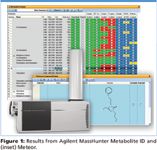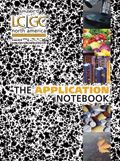Software-Assisted Identification of Metabolites
The speed and accuracy of software-assisted identification of metabolites can be further improved by combination with rule-based metabolite prediction software.
Edgar Naegele1, Horst Lehmann1, Sian E. Ives2, and Kate Langton2, 1Agilent Technologies, Inc. and 2Lhasa Limited
The speed and accuracy of software-assisted identification of metabolites can be further improved by combination with rule-based metabolite prediction software.
Metabolism of pharmaceuticals often generates many metabolites. Those resulting from a single reaction are easy to predict and identify. However, cleavage reactions resulting in fragments that undergo further reactions can change the molecule significantly, and manual prediction and identification of such metabolites can be difficult. The use of metabolism prediction software such as Meteor, (Lhasa Limited, Leeds, UK) together with Agilent MassHunter Metabolite ID software provides a solution.
Experimental
Equipment
Agilent 1290 Infinity LC system
Agilent ZORBAX RRHD SB-C18 column, 2.1 × 100 mm,
Agilent 6530 Accurate-Mass Q-TOF LC–MS
Metabolite Sample
Nefazodone in phosphate buffer + Microsmal S9 preparation + NADPH solution (control sample without NADPH).
Data Analysis
All detectable mass signals from the MS-level data of the metabolite and control samples were extracted using the Molecular Feature Extraction (MFE) algorithm. The lists of compounds detected in both samples were compared; all compounds in the metabolite sample that were new or had doubled signal intensity were considered potential metabolites and subjected to further analysis.
Meteor (Version 11) was used to produce a metabolic tree for nefazodone. The metabolites were saved as an SD (structure-data) file suitable for input to the Metabolite ID software. The SD file was searched against all compounds, and matching masses were assigned to the corresponding structures.
Results
The results of the comparisons of the potential metabolite data with the parent drug data by the different algorithms are displayed in a color-coded result table: an algorithm that exceeds its specified threshold is marked in green.
Those metabolites assigned to known metabolic reactions are "expected metabolites;" others, where not all algorithms exceed the specified threshold, are "unexpected metabolites," e.g., the compound eluting at 8.13 min with m/z 292.1663 (see Figure 1). Meteor predicted a metabolite with a calculated mass of 291.1583, whose structure and formula (C15H21N3O3) could be assigned to this unexpected metabolite. A comparison of the measured isotopic pattern of the metabolite compound with the calculated isotopic pattern of nefazodone shows a significant difference, due to the loss of the chlorinated phenyl ring from the parent molecule. The formula of the metabolite is confirmed by accurate mass measurement. The isotopic pattern of the metabolite compound is also confirmed by accurate mass measurement.

Figure 1
The Meteor-assigned structure is confirmed by the MS-MS spectrum, where formulas calculated for all ions can be assigned to a structure fragment.

Conclusion
Rule-based metabolite prediction software can serve as a source of metabolite structures for consideration by the MassHunter Metabolite ID software. Compounds that cannot be identified or qualified based on known metabolic reactions can be assigned structures generated by Meteor, based on mass and formula information. Assignments can be confirmed by accurate mass measurement.

Agilent Technologies, Inc.
5301 Stevens Creek Blvd., Santa Clara CA 95051
tel. (877)424-4536, (408)345-8886; fax (408)345-8474
Website: www.agilent.com

SEC-MALS of Antibody Therapeutics—A Robust Method for In-Depth Sample Characterization
June 1st 2022Monoclonal antibodies (mAbs) are effective therapeutics for cancers, auto-immune diseases, viral infections, and other diseases. Recent developments in antibody therapeutics aim to add more specific binding regions (bi- and multi-specificity) to increase their effectiveness and/or to downsize the molecule to the specific binding regions (for example, scFv or Fab fragment) to achieve better penetration of the tissue. As the molecule gets more complex, the possible high and low molecular weight (H/LMW) impurities become more complex, too. In order to accurately analyze the various species, more advanced detection than ultraviolet (UV) is required to characterize a mAb sample.














